![]() Keyboard Maestro
Keyboard Maestro
Conduct your Mac Like a Pro!
![]() Keyboard Maestro
Keyboard Maestro
Conduct your Mac Like a Pro!
This window welcomes new users and gives you some options for learning about Keyboard Maestro.

If you are new to Keyboard Maestro, start the tutororial and Keyboard Maestro will walk you through creating a simple macro.
This window lets you manipulate Macros and Macro Groups, creating new ones, deleting old ones, enabling and disabling them, editing them and so on.
You get this window pane by launching Keyboard Maestro.

The window contains a list of Macro Groups and their associated Macros.
You can create a new Macro Group by clicking the button below the Groups list.
You can create a new Macro by selecting a macro group and then clicking the button below the Macros list.
You can see the selected Macro Group or Macro in the right hand column, and edit it by clicking the Edit button.
You can select the All Macros meta-Group to show all Macros, and you can use the search field to filter down the list of macros.
You can rename a Macro Group or Macro by double clicking it and changing the title.
You can delete a Macro Group by selecting it and clicking the button below the Groups list.
You can delete a Macro by selecting it and clicking the button below the Macros list.
Similarly, you can enable or disable Macro Groups or Macros by clicking their respective button.
You cannot delete, rename or modify the Global Macro Group.
See also the Macros and Macro Editor Window sections.
If you are new to Keyboard Maestro, start the tutororial by clicking the button in the Welcome window or by choosing Tutorial from the Help menu and Keyboard Maestro will walk you through creating a simple macro.

Follow the instructions. Keyboard Maestro will hilight the location of the various buttons to help you quickly create a macro. You can even use the tutorial as a wizard to create a hot key triggered macro to perform any of Keyboard Maestro’s many actions.
To edit a Macro Group, select it and click the Edit button. Its details will be shown in the right hand column. You can edit its name, control which applications it is available in, and how it will be activated.
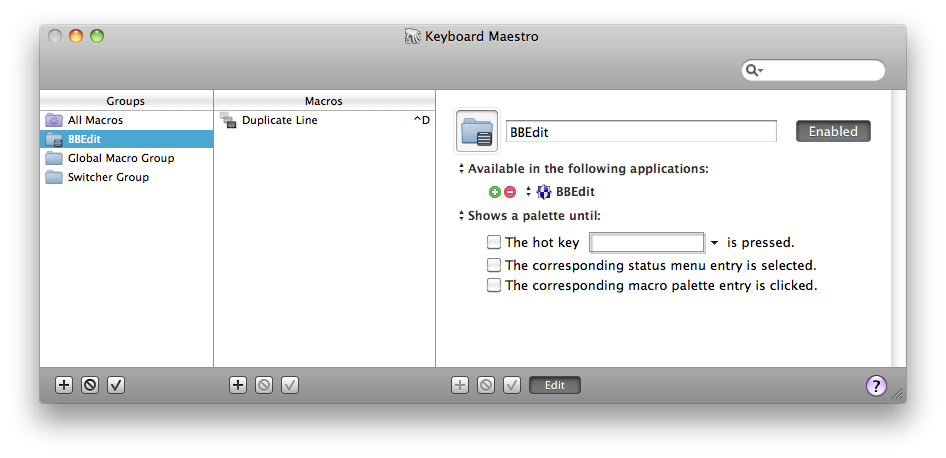
Typically a group’s macros would be available everywhere (available in all applications), or it might be specific to a particular application (available in the following applications) in which case you might name the Macro Group after the application.
You can also configure the macro group to be activated only after a Hot Key press (either for a single use or toggled on and off), and whether to display the macros in a floating palette.
See also the Macros section.
To edit a Macro, select it and click the Edit button. Its details will be shown in the right hand column. You can edit its name, add or remove triggers, and configure its action list.
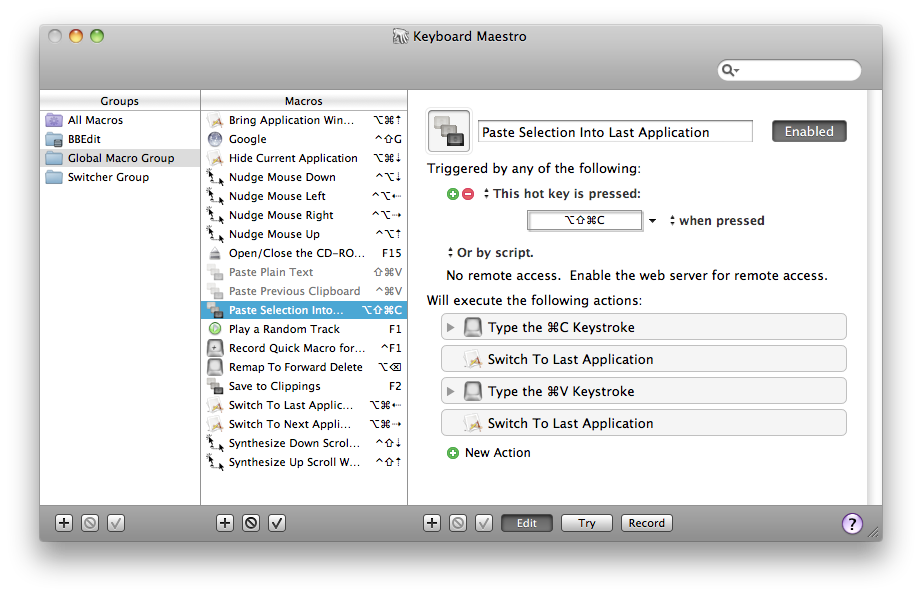
To add a trigger, click the green button and select the type of trigger. To remove a trigger, click the red button.
To see how to execute this macro via a script, select from the “Or by script”’ menu.
How you can execute the macro remotely is also displayed.
To add an action, click the New Action button, or equivalently the button below the detail view. This will show the lists of possible actions. Double click one of them to add it to the action list for this macro.
You can also Copy and Paste actions, as well as drag them around to rearrange them. Use the button and button to delete or enable/disable the selected actions.
You can try the selected actions by clicking the button.
You can click the button to record your actions.
To learn more about creating or editing Macros, see the Macros section.
This window shows you when Keyboard Maestro is recording your actions.
You get this window by clicking the button in the Macro Editor window or by triggering a Record Quick Macro action.

Clicking on this window will stop all recording.
To learn more about recording, see the Recording section.
This window lets you switch between active programs, as well as quit or hide programs or quickly launch frequently used programs.
You get this window by triggering the Program Switcher macro.

To learn more about the Program Switcher, see the Program Switcher section.
This window lets you switch between windows in the current application, as well as close or minimize windows.
You get this window by triggering the Window Switcher macro.
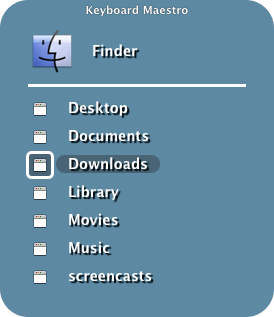
To learn more about the Window Switcher, see the Window Switcher section.
This window lets you select between named clipboards to Cut, Copy or Paste to/from.
You get this window by triggering one of the Clipboard Switcher macros.
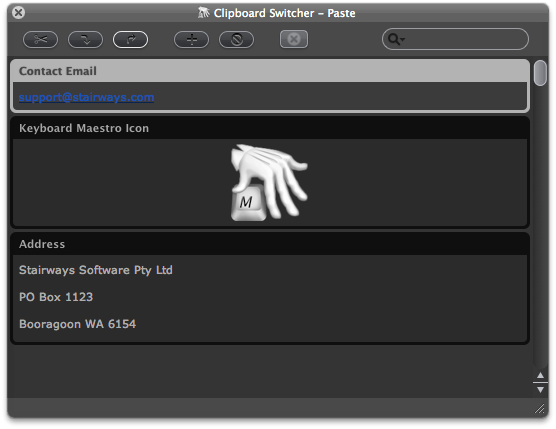
Select something and select a named clipboard and click the button or button to cut/copy to a named clipboard. Select a named clipboard and click the button button to paste a named clipboard. Click the button to create a new named clipboards. Select a named clipboard and click the button to delete it.
Click the button to toggle whether the window show close after an action.
Use the search field to filter the named clipboards.
To learn more about the Clipboard Switcher, see the Clipboard Switcher section.
This window lets you paste from your clipboard history of items that you have previously cut or copied.
You get this window by triggering the Clipboard History Switcher macro.

Select something cut or copy and it will appear in this list. Select an item and click the button button to paste a named clipboard. Click the button to copy the current selection. Select an item and click the button to delete it (this is useful if you want to delete a password or other sensitive information).
Click the button to toggle whether the window show close after an action.
Use the search field to filter the named clipboards.
To learn more about the Clipboard History Switcher, see the Clipboard History Switcher section.
This window lets you configure Keyboard Maestro.
You get this window by launching Keyboard Maestro and choosing Preferences from the Keyboard Maestro menu.
To learn more about the Preferences, see the Preferences section.
This window pane lets you configure general preferences.
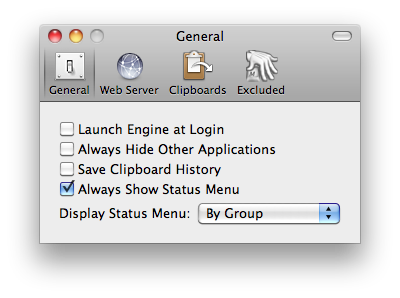
This window pane lets you configure the built-in web server which enables remote execution of macros.
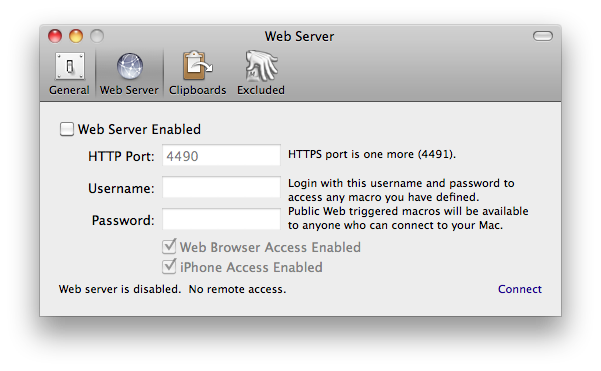
This window pane lets you add, remove and rename Named Clipboards.
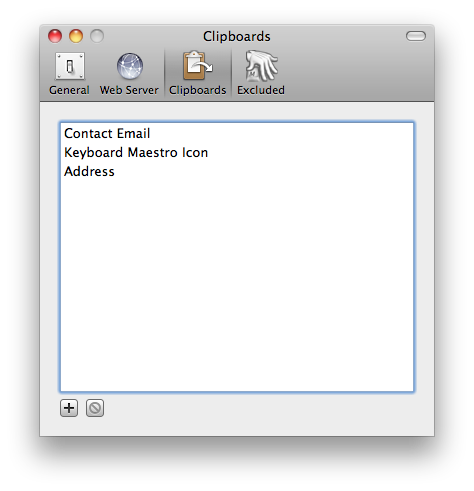
This window pane lets you add and remove applications from the global Excluded Applications list.
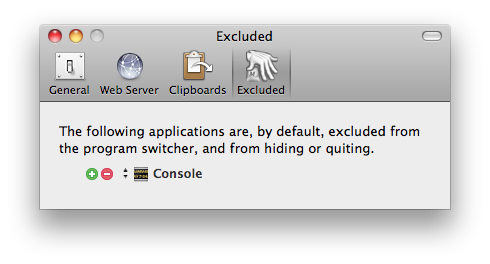
This window shows you the version of this copy of Keyboard Maestro, to whom it is registered, and allows you to visit the web site.
You get this window by launching Keyboard Maestro and clicking the About tab.
